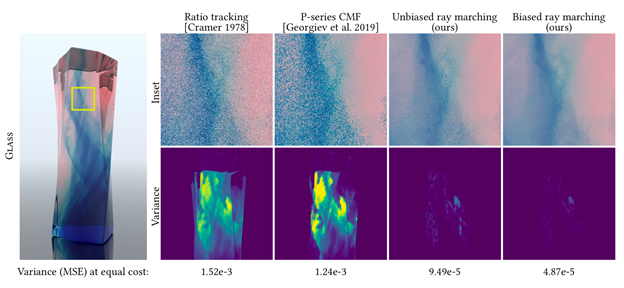 NVIDIA researchers will present their paper “An Unbiased Ray-Marching Transmittance Estimator” at SIGGRAPH 2021, August 9-13, showing a new way to compute visibility in scenes with complex volumetric effects.
NVIDIA researchers will present their paper “An Unbiased Ray-Marching Transmittance Estimator” at SIGGRAPH 2021, August 9-13, showing a new way to compute visibility in scenes with complex volumetric effects.
NVIDIA researchers will present their paper “An Unbiased Ray-Marching Transmittance Estimator” at SIGGRAPH 2021, August 9-13, showing a new way to compute visibility in scenes with complex volumetric effects.

When Monte Carlo sampling is used to compute lighting effects such as soft shadows and global illumination, shadow rays are used to query the visibility between lights and surfaces. In many scenes, visibility is a simple binary answer that is efficiently queried using the RTX RT Cores. However, for volumetric effects such as clouds, smoke and explosions, visibility is a fractional quantity ranging from 0.0 to 1.0, and computing this quantity efficiently and accurately between any two points in a scene is an essential part of photorealistic real-time rendering. Visibility that accounts for volumetric effects is also called transmittance.
We present a new algorithm, which we call unbiased ray marching, for evaluating this transmittance in general scenes. Our key result is a new statistically-unbiased Monte Carlo method that randomly queries the volume densities along a ray and computes a visibility estimate from these values. For high-performance rendering, the goal is to compute an accurate low-noise estimate while minimizing the number of times the volume data needs to be accessed.
The research paper provides a new efficiency analysis of the transmittance estimation problem. This yields a number of key insights about when and how various transmittance estimators achieve the optimal balance of low noise and low cost. Building on these insights, and leveraging previous work from graphics, physics and statistics, we derive a new transmittance estimator that is universally optimal relative to 50 years of prior art, and often ten times more efficient than earlier methods. Technically, the end result is based on a power-series expansion of the exponential function that appears in the transmittance equation, and 90% of the time our new estimator simply evaluates the first term in this expansion. This first term corresponds to the traditional biased ray-marching algorithm. The subsequent terms of the expansion, which our estimator evaluates 10% of the time, correct for the bias. This key insight allows us to benefit from the efficiency of ray marching without being plagued by its bias – occasional light-leaking artifacts seen as, for example, overly bright clouds.
The new method helps to reduce the noise of shadows, such as the one cast on the floor by the smoke plume in the above figure where we see a dramatic reduction in noise at the same render time.
Putting a new twist on an old method, unbiased ray marching virtually eliminates a common source of noise in path-traced renderings of scenes with rich volumetric effects.
Learn more: Check out the project website.
